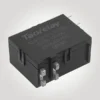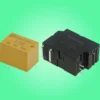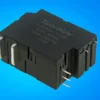Introduction
In today’s energy-conscious and compact electronic designs, low voltage latching relays are gaining increasing attention. These relays offer efficient switching capabilities at low operating voltages, making them ideal for battery-powered devices, smart home systems, and portable electronics.
This article explores what a low voltage latching relay is, how it works, and why it is becoming a preferred solution for modern, energy-sensitive applications.
What Is a Low Voltage Latching Relay?
A low voltage latching relay is a type of bistable relay that operates at relatively low control voltages—typically 3V, 5V, 6V, 9V, or 12V. Unlike traditional relays that require continuous current to maintain their contact position, a latching relay holds its position after receiving a short control pulse. This is made possible through a magnetic or mechanical latching mechanism.
The “low voltage” designation refers specifically to the voltage required to actuate the relay coil, not necessarily the load voltage.

How It Works
Low voltage latching relays are available in:
- Single-coil designs, where reversing polarity toggles the relay position
- Dual-coil designs, with each coil controlling one switching direction
Once the state is changed by a pulse, no holding current is needed, which significantly reduces power consumption.
Key Features of Low Voltage Latching Relay
- Operates at low control voltages (3V–12V)
- Power is only required during switching
- Excellent for battery-powered and off-grid devices
- Maintains state even during power loss
- Compact and energy-efficient design
- Available in SPST, SPDT, DPDT configurations
Common Applications
Low voltage latching relays are widely used in scenarios where energy efficiency, compact size, and reliable state memory are essential.
1. Battery-Powered Devices
- Remote controls
- Medical equipment
- Wireless sensors
- Portable alarms
2. Smart Home Systems
- Light switch modules
- Curtain/blind controllers
- HVAC relay control
- Home automation hubs
3. Wearable & Portable Electronics
- IoT devices
- Smart locks
- Fitness trackers
- Smart meters
4. Energy-Efficient Products
- Solar-powered systems
- Off-grid automation
- EV battery management systems
- Renewable energy controllers
Benefits of Using Low Voltage Latching Relays
- ✅ Ultra-low power consumption
- ✅ Reliable switching in compact circuits
- ✅ Retains state without constant power
- ✅ Ideal for embedded systems and microcontrollers
- ✅ Enhances battery life of portable products
- ✅ Minimal heat generation during operation
Choosing the Right Low Voltage Latching Relay
When selecting a low voltage latching relay, consider the following:
- Coil voltage (e.g., 5V, 9V, 12V)
- Contact rating (voltage/current switching capacity)
- Coil resistance and power consumption
- Switching type (single or dual coil)
- Physical footprint for your PCB or housing
Always check product certifications like RoHS, CE, or UL depending on your target market.
Conclusion
The low voltage latching relay is a powerful solution for low-energy, intelligent switching needs. Its ability to maintain its position without a constant power supply makes it perfect for a wide range of modern electronics, especially where power savings and size constraints are key concerns.
If you’re designing next-generation smart devices or energy-saving solutions, integrating a low voltage latching relay can significantly enhance efficiency, reliability, and performance.




